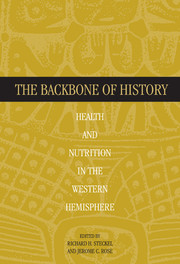Book contents
- Frontmatter
- Contents
- Preface
- List of Contributors
- PART I
- PART II METHODOLOGY
- PART III EURO-AMERICANS AND AFRICAN-AMERICANS IN NORTH AMERICA
- PART IV NATIVE AMERICANS IN CENTRAL AMERICA
- PART V NATIVE AMERICANS AND EURO-AMERICANS IN SOUTH AMERICA
- Introduction
- 12 Patterns of Health and Nutrition in Prehistoric and Historic Ecuador
- 13 Economy, Nutrition, and Disease in Prehistoric Coastal Brazil: A Case Study from the State of Santa Catarina
- PART VI NATIVE AMERICANS IN NORTH AMERICA
- PART VII
- PART VIII
- PART IX EPILOGUE
- Index
13 - Economy, Nutrition, and Disease in Prehistoric Coastal Brazil: A Case Study from the State of Santa Catarina
Published online by Cambridge University Press: 01 March 2010
- Frontmatter
- Contents
- Preface
- List of Contributors
- PART I
- PART II METHODOLOGY
- PART III EURO-AMERICANS AND AFRICAN-AMERICANS IN NORTH AMERICA
- PART IV NATIVE AMERICANS IN CENTRAL AMERICA
- PART V NATIVE AMERICANS AND EURO-AMERICANS IN SOUTH AMERICA
- Introduction
- 12 Patterns of Health and Nutrition in Prehistoric and Historic Ecuador
- 13 Economy, Nutrition, and Disease in Prehistoric Coastal Brazil: A Case Study from the State of Santa Catarina
- PART VI NATIVE AMERICANS IN NORTH AMERICA
- PART VII
- PART VIII
- PART IX EPILOGUE
- Index
Summary
ABSTRACT
The Northern Coast of the State of Santa Catarina, Southern Brazil, was first occupied around 5000 bp by populations of preceramic shellfishers, who were partially replaced by ceramist groups around ad 1000. Most Brazilian archaeologists assume that there is a strong correlation between pottery making and plant cultivation. Therefore, these later groups are said to have introduced agriculture to the region. In this chapter we explore temporal health trends among these prehistoric populations in order to test the hypothesis that ceramist groups introduced plant cultivation into the region. We also survey the general health status of these coastal Brazilian populations, comparing them with other archaeological samples represented in the joint project. To do so, we used the following osteological markers of quality of life: incidence of dental caries, degree of tooth wear, incidence of linear enamel hypoplasias, and incidence of porotic hyperostosis in the orbits.Two of the preceramic sites showed a high incidence of dental caries, demonstrating that in specific moments of the preceramic period, some of the groups relied on plant resources at least as much as they did on animal sources. None of the osteological markers traditionally associated with the adoption of agriculture showed higher frequencies in the ceramic level compared to the preceramic level. Thus, we conclude that although pottery making was introduced on the Northern Shore of the State of Santa Catarina by ad 1000, our data do not support that the adoption of agricultural practices was associated with this introduction. We found that the populations of both prehistoric occupations attained very high indexes of health and quality of life.
- Type
- Chapter
- Information
- The Backbone of HistoryHealth and Nutrition in the Western Hemisphere, pp. 376 - 400Publisher: Cambridge University PressPrint publication year: 2002
- 9
- Cited by



